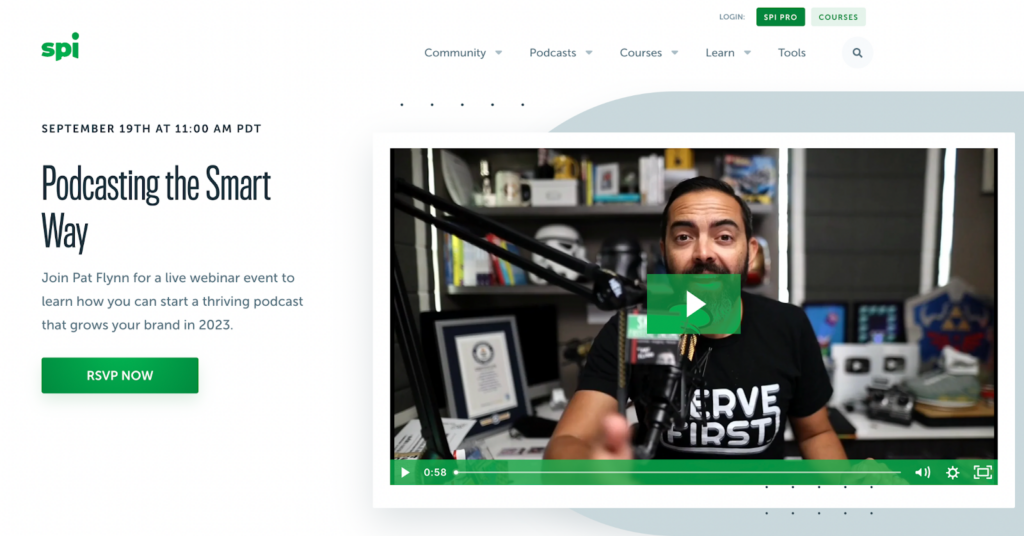If you’ve used the internet long enough, there’s a good chance you’ve entered your name and email address to get access to a free eBook, checklist, online course, or some other resource.
The content content that was magically you got delivered to your inbox is called gated content — and it plays a pivotal role in digital marketing.
In this comprehensive guide, you’ll learn:
- What is gated content?
- Types of gated content
- Designing the perfect gated landing page
- Gated content best practices
- Gated content tools and platforms
- Unlocking your gated content potential
- FAQ
Let’s dive in.
What is gated content?
Gated content refers to any kind of online content that users can only access in exchange for their contact information. This content is usually hidden behind a lead capture form that asks for the visitor’s name and email address. Depending on what the gated content is being used for, use cases of the gated content, the form may ask for additional information, such as the visitor’s user’s job title, name of their organization, and organization size.
Besides the initial ‘form’ where visitors input their personal information, gated content is completely free and not hidden behind a paywall.
You might be asking, “why would I hide my content behind a form?”
Short answer: To generate high-quality leads for your business.
Gating your content is a fairly easy way to get the contact information of people who are interested in what you have to offer. That’s the difference between generating leads and driving traffic. With website traffic, not every visitor is committed to becoming long-term customers / clients of yours. In fact, most of them will only visit one page of your site. But when someone likes your content enough to give you their name and email address, there’s a better chance of them becoming your customer or client in the future.
With gated content, you’re offering something of value that your ideal customer or client wants. Since Google doesn’t notice or pick-up on content that’s hidden behind a registration wall/form, fewer people will find this content right away, unless it’s strategically placed. But when visitors do access this gated content and give you their information in exchange for it, a doorway opens that allows you to send lead nurturing emails straight into their inbox to reel them in.
Gated content vs. ungated content: making the choice
Unlike gated content, ungated content is freely accessible to all your website visitors without them having to fill out a form or pop-up. This content can also be found in the search engine results pages (SERPs) because they’re not hidden.
While gated content is mainly used to generate leads, ungated content serves to increase brand awareness and improve search engine optimization (SEO). This includes blog posts, YouTube videos, infographics, and more.
When deciding whether or not to gate your content, ask yourself these questions:
- What’s your goal? Do you want to build brand awareness or generate leads? If brand visibility is your goal, ungated content is the better option because it’s easily accessible and can be crawled and ranked by Google’s algorithms. For lead generation, gated content is the way to go because it helps filter out regular visitors from people who are interested in your offerings.
- Is the content valuable enough to be gated? If you’re going to ask people for their contact information before they get access to your content, that content has to be “premium”. It has to go beyond your regular blog posts. Think 15-page eBook, an original research report, or even a free tool trial.
- Do your competitors already offer this content ungated? If your business rivals are offering the same content for free, your target audience can simply get access to it from your competitors, which puts you at a disadvantage. The goal is to make your content valuable enough that people can’t find the equivalent elsewhere.
- What information will you need? Overly long lead capture forms turn people away, so be careful with how much information you ask for in your form or pop-up. If you can make do with just their name and email address, don’t over-complicate things by asking for their job title and organization size.
The pros and cons of gated content
Gating your content is a great way to pique your visitors’ interest and encourage them to take action. However, because of the form or pop-up, it won’t be very visible. And even when people find it, the effort may deter them. So before gating your content, here are some factors you need to consider:
| Pros | Cons |
| Find high-quality leads. When you hide your content behind a form, you’re ensuring that the people who sign up to get access are more than regular visitors. These people know what they want and are looking for ways to achieve it with your offer.
This way, you can build a list of high-quality leads you can nurture until they convert to paying customers or clients. |
You’ll have low reach. If your content is behind a form, Google won’t be able to notice or crawl it, so it won’t rank like your regular blog posts. As a result, it won’t get a lot of reach, traffic, and engagement.
There’s also the possibility that people who are really interested in your offer might not see your gated content. |
| Grow your email list. The people who give you their name and email address to get access to your gated content are automatically added to your email list — which is one of the most effective ways to promote your offerings.
Gated content serves as an incentive, so you’re not just asking people to drop their personal information blindly without a promise of anything in return. |
You’ll scare off some people. If you’ve had your inbox overflowing with brand emails that you know you’ll never read, you may understand why some people who are genuinely interested in your business still won’t give you their personal information.
|
| Segment your email list. If you offer different products suited for different kinds of people or use cases, it’ll be helpful if your email list is divided into relevant categories. This way, you can send the right emails to each category, depending on their needs/wants of your visitors.
Gating your content helps you segment your email list because you can ask for additional information, including job title, company size, and objectives. |
You may capture false information. Even though a form protects your content, it doesn’t stop people from dropping false information just to get access.
So you might get fake names, phone numbers, temporary email addresses and more — which will dent your email list and make you waste resources trying to convert someone who isn’t interested. |
| Build trust between your brand and your target audience. When someone gives you their email address, they’re telling you that they trust your brand to a extent. It’s up to you to build upon that trust by sending them relevant and helpful content, and delivering on your promises. | You may lose people’s interests if you don’t deliver. If someone takes the time to fill out a form to get access to your content and the content isn’t good or valuable to them, you’ll lose the person. They’ll be disappointed and they may even unsubscribe from your email list. |
Types of gated content
Gated content can come in different formats. Some of them include:
-
Whitepapers
A whitepaper is a, in-depth report on a specific topic. In a whitepaper, the writer explains a concept in great detail, such as what a product is, what it’s made of, how it works, and why it’s better than similar products in the market.
If you’re in the B2B industry, whitepapers make for great gated content because of the value they provide. Not only can they be relevant and helpful to your audience, but they can also position your brand as a thought leader in your industry. Being considered a trusted expert increases the chances of people paying attention to what you offer.
-
eBooks
Just like whitepapers, eBooks are another way to establish your authority and expertise in your industry. The use of eBooks isn’t just limited to the B2B industry; you can also use it in the B2C, DTC, and even eCommerce industries.
To get the best results, ensure that your eBook is worth reading before asking people to fill out a form. In fact, you can give away the first chapter of your book for free and then ask for their contact information in exchange for the rest. This increases the chances of people signing up.
eBooks are often used in the awareness and consideration stage of the buyer’s journey (we’ll get to this soon). For example, Pipedrive, a CRM tool for salespeople, created a free sales pipeline course eBook that’ll help businesses generate more deals.
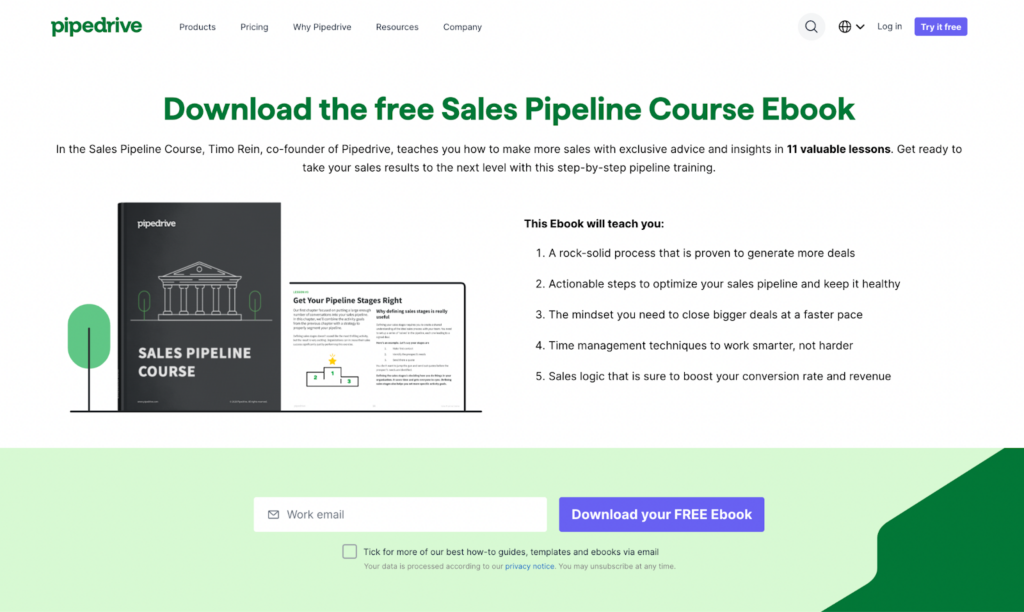
Not only will this eBook show business decision-makers that the folks at Pipedrive know a bit about sales, but it’ll may also convince them to use the tool itself to optimize their sales pipeline.
Pro tip: Just like Pipedrive, you can offer people additional resources, including how-to guides and templates.
-
Online courses
Some brands prefer to offer online courses to visitors in exchange for their contact information. A classic example is Yoast, the all-in-one SEO company that offers free SEO training to interested visitors.

To get access to this free course, users will have to sign up with their email address and password. However, Yoast SEO offers many types of free gated content, so anyone who signs up gets access to it all, not just the free SEO course.
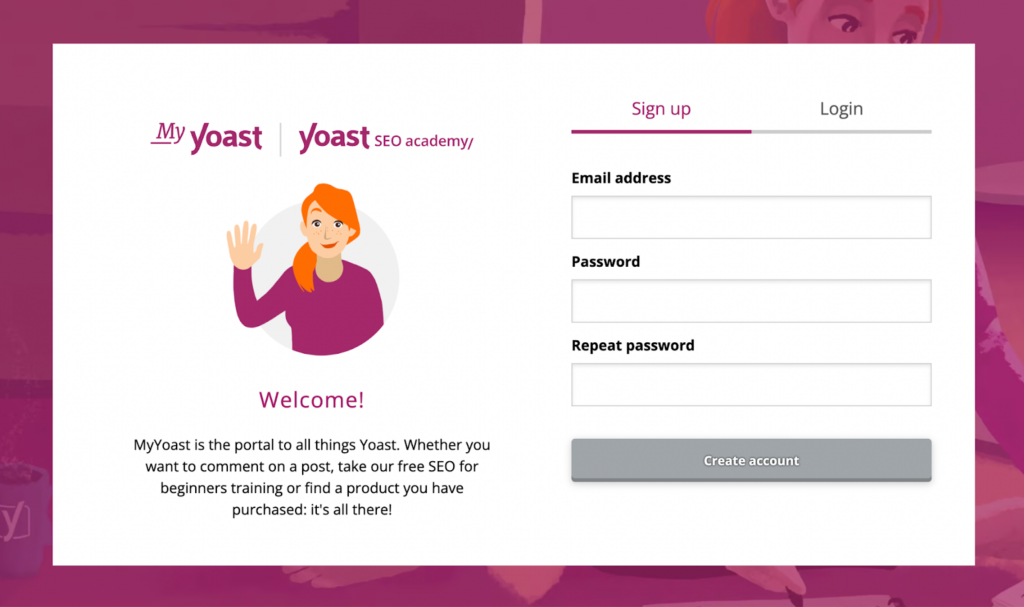
Pro tip: In Yoast SEO’s landing page, there’s also the option to pay $99 per year for Yoast SEO premium, which unlocks access to all Yoast SEO courses and the plugin, among other things. This setup is a great way to show people how your free offer compares to your paid one(s) and allow them to choose which one they want.
-
Templates
Many professionals are constantly on the lookout for ways to save time and automate repetitive tasks. That’s why templates make for great gated content pieces. Because templates can save several hours of time and help them get through work more easily, people are usually willing to give up their details in exchange for them.
These templates include, but aren’t limited to:
- Google Slides or PowerPoint templates
- Microsoft Excel spreadsheets
- Workflows
- KPI calculators
For example, in exchange for only an email address, Thinkific offers lesson plan templates that make it easier for online course creators to plan their lessons.
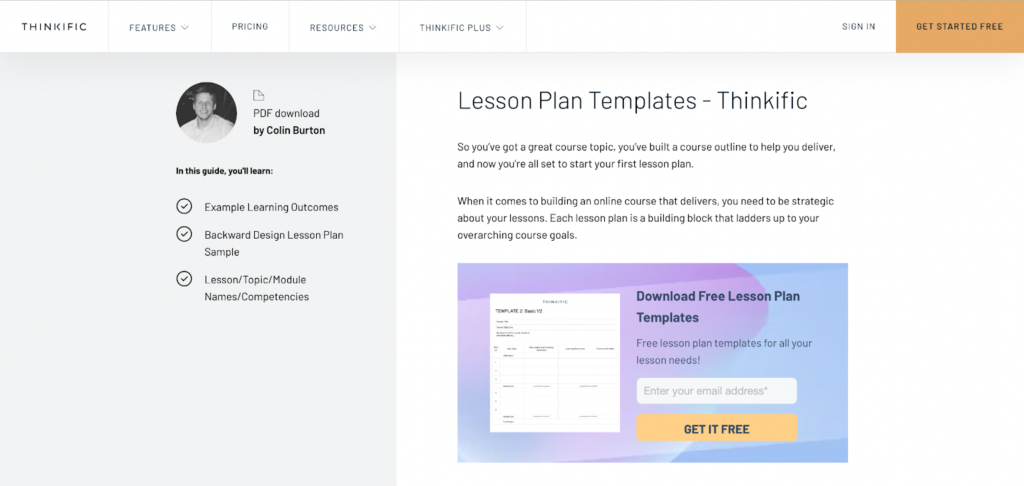
-
Email series
Since anyone who signs up on your lead capture form gets added to your email list, it only makes sense to send them an email series. Usually, these email series are like mini-courses that give a surface-level explanation of a certain concept. Businesses use this as a precursor to a paid course that delves deeper into the subject.
For their email series, most brands send one email to new subscribers each day for 5-10 days. On the last day, they introduce their paid course and encourage subscribers to pay for it.
-
Webinars
Webinars are usually gated because they’re valuable and interactive; they allow professionals to educate their audience on a topic, answer questions in real-time, and pitch their product at strategic points during the session.
Live webinars also have a limited number of slots, so there’s an element of scarcity that makes people willing to give their email address in exchange for a slot. This makes people believe that webinars have more value than regular blog posts and even pre-recorded videos.
For example, Pat Flynn of Smart Passive Income, invited interested people to register for a live webinar event where he taught them how to create and run a thriving podcast.
Just like with all gated content, when someone registers for your webinar, they’re automatically added to your email list, so you can send future webinars and other resources to them.
Pro tip: It can be hard to get people to sign up for your webinar, so you’ll have to start promoting it on different platforms well before the day of the event.
-
Product demos
If you have a tool you want people to pay for, you can attract them by offering a product demo. It’s similar to when people test-drive a car before they consider buying it.
When you gate your product demos, the people who sign up are making a conscious choice to receive more resources from you in the future. They’re also showing you that they have ample interest in your product — so it’s up to you to ensure that the demo shows the power of your product.
Note: Some companies ask prospects to schedule a demo via phone or email. You can take this route if you think it’d be more compelling to meet with a prospect face-to-face and explain how your product works — rather than have them watch a pre-recorded demo.
-
Private communities
Nothing screams “exclusivity” quite like a private community; that’s why most businesses gate their communities. Once someone enters their email address, they’ll be a part of an exclusive group filled with people who share common interests and goals.
Everyone in the group gets access to content such as articles, videos, and other media shared within the community. And depending on the kind of business you run, you can offer people one-on-one interaction with you if they sign up.
To show how valuable a private community is, a form asking people to join his community of over 330,000 entrepreneurs stays front-and-center on Ryan Robinson’s website. In this community, people will learn about blogging, business, freelancing, and podcasting, to mention a few.
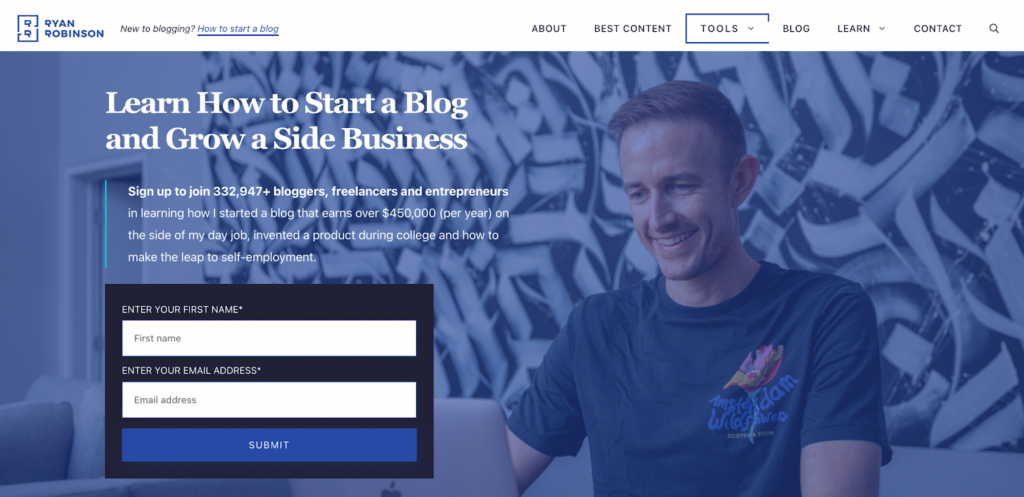
Designing the perfect gated landing page
After creating the content you want to gate, you’ll need a place to “host” it. Like you saw in the examples above, most businesses/marketers use a dedicated landing page, which contains information about the gated content as well as a form that an interested visitor has to fill out to gain access.
Visitors, however, won’t fill out the form if the landing page itself is not convincing enough. Since people generally won’t see the content without filling out the form, you want your landing page to convince them that your content is valuable and relevant. If not, they won’t sign up.
To create a high-converting gated landing page, here are the steps to follow:
-
Create high-value content
Everything on your landing page will revolve around the content you want to gate. If your content isn’t valuable, no one will sign up for it. You could get Shakespeare to write your landing page, and it still won’t make a difference if your offer isn’t good. In fact, it’ll likely have the opposite effect and ruin your brand reputation.
To determine if your content is worthy enough to be gated, ask yourself:
- Does this offer solve a problem for my audience?
- What are the benefits of this information I’m offering to people?
- Is this content better than my competitors’ ungated content?
If your answer is yes on all three questions, let’s move to the next step!
-
Choose a good landing page tool
If you’re going to make a landing page, you need a landing page tool — unless you want to write the code for it from scratch (which is fine, too). But if you don’t have coding knowledge or you’d rather save time, try using landing pages tools like:
- Thinkific
- Elementor
- Instapage
- Leadpages
- Unbounce
These tools often have tons of pre-made landing page templates and a drag-and-drop editor you can use to customize the templates to align with your brand.
-
Nail your sales copy
Writing your sales copy is arguably the most important part of crafting an effective landing page, because it determines whether or not people sign up for access to your content. Even though you’re not selling the content right away, your goal is to generate leads you’ll sell to later on.
So you have to nail your copy right from the headline, which should be attention-grabbing and compelling.
With your sales copy, you don’t need too many words; you only need the right words. Your copy should:
- Be clear and concise: Don’t ramble or provide extraneous details about your offer, or your visitors may bounce. Instead, skip to the point. Use clear, simple language to describe what your product or service is about and how it can improve the lives of your target audience.
Instead of using big blocks of text, try subheading and bullet points to get rid of the fluff and make your landing page skimmable.
Focus more on the benefits of your gated content than on the features.
- Evoke emotion: As much as we like to think we are logical and rational beings, most people make buying decisions based on emotions. To tap into the emotions of your target audience, talk about their desires.
For example, in his sales page for his eBook, The Autonomous Freelancer, Dominic Kent tugs at the emotions of his target audience by asking: “Have you ever felt like you could be working more productively? Is there part of your freelance business that you wish just went away?”
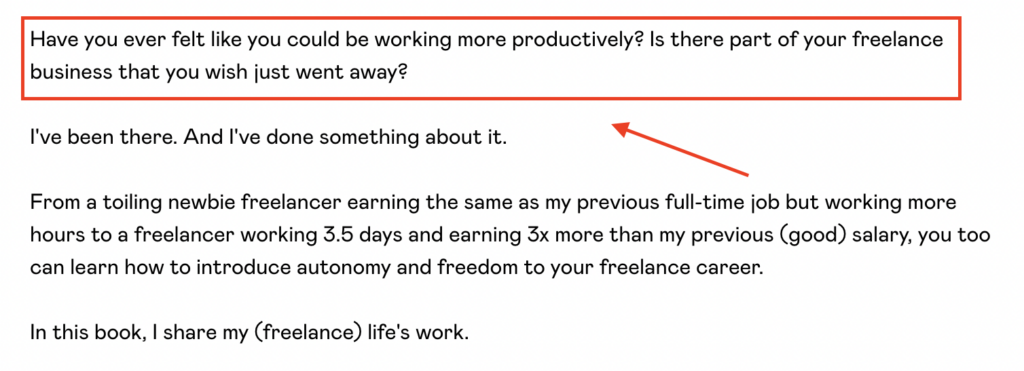
While the eBook itself is not gated (it’s paid), these questions are a great example of what it’s like for your landing page copy to evoke emotion.
-
Use stunning imagery/media
What’s a landing page without striking imagery? Even though your copy does the heavy lifting, you should supplement it with pictures and/or videos of your product. This is especially important if you’re gating templates, eBooks, and product demos.
Sometimes, all you need to convince people to sign up is a teaser of what they’ll get when they do. This could be eBook covers, infographics, or video snippets. Whatever media format you use, ensure that it’s high quality, on-brand, and professional.
-
Have a good call-to-action
Your call-to-action (CTA) is a text prompt that tells visitors what to do when they visit your landing page. Usually, your CTA appears as a button on the lead capture form, right underneath the form fields for name and email address (and other information you ask for).
The text itself doesn’t have to be complicated. Phrases like “Download Now,”, “Sign Up Here,”, “Get Your Template,” and “Book a Demo” are direct enough. But you need to ensure that the CTA button(s) has a color that is eye-catching and is positioned where visitors can’t miss it.
Pro tip: Position the first CTA button on your landing page above the fold, so visitors will see it immediately.
-
Include social proof
If you’ve ever bought something solely because your friend or family member recommended it to you, then you probably understand how powerful social proof is. Social proof, a term coined by American psychologist Robert Cialdini, dictates that people’s decision-making is often influenced by others.
That’s why people who want to buy products online first check the reviews and testimonials. Good reviews instill confidence in prospective buyers that a product is as good as the creator says it is.
The same applies to your gated content. You can yell its benefits from the top of the Empire State Building, but if there’s no proof that your content is effective, people will be disinclined to sign up for it. You can prevent this by placing customer reviews and testimonials strategically on your landing page.
These stellar reviews show that other people have signed up for your product or service and got great results. This makes potential subscribers think, “if this content can work for them, it can work for me, too.”
-
Craft a “thank you” page
When someone gives you their contact information when they could’ve chosen not to, you say “thank you.” Literally.
After someone signs up to get access to your gated content, it only adds to the user experience if there’s a thank you page right after. It’s like a warm handshake that seals a deal between you and the person.
There are many ways you can approach this, but here are two things to keep in mind:
- Say thanks: Let your visitors know that they’ve successfully completed the form and that you’re thankful that they did. You can even congratulate them if the content is an eBook or mini-course.
- Set expectations: Let subscribers know what to expect next. If your content is downloadable, tell them to check their inbox for it. If it’s a webinar, confirm the date and tell them where to find the link to join. And if you’ll be sending them emails in the future, let them know so there won’t be any surprises.
Gated content SEO: optimize gated content for search engines
Even though Google doesn’t crawl content that’s hidden behind a form, there are two ways to use SEO to boost the visibility of your gated content:
- Optimizing your landing page for relevant keywords
- Embedding your lead capture form within your ungated, SEO-optimized content, just like Thinkific did in this article.
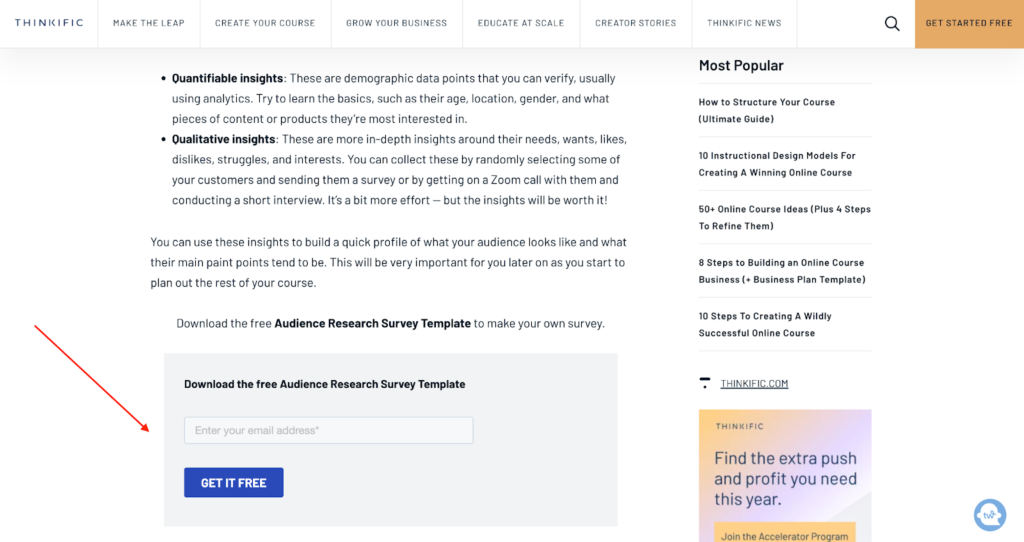
Both methods require you to use the three major forms of SEO to get maximum visibility on the SERPs: on-page SEO, off-page SEO, and technical SEO.
-
On-page SEO
On-page SEO involves optimizing the content on your landing page or website for search engines. This involves using relevant, high-volume keywords in specific parts of your content, including title tags, (sub)headings, content body, image alt texts, meta descriptions, and URLs.
This way, when Google’s algorithms crawl your content, they know what it’s about and are able to rank it for the right search query.
-
Off-page SEO
While on-page SEO happens on the landing page or blog post itself, off-page SEO are all the optimization methods you make outside the webpage to boost its SERP ranking. This includes link building, local SEO, social media marketing, paid advertising, influencer marketing, public relations (PR), guest posting, and brand mentions.
Link-building is especially important because Google regards it as a core ranking factor. It involves getting other reputable websites to link to the landing page and/or blog post through which people can access your gated content. When other websites link to you, it signals to Google that your offer is legitimate, relevant, and helpful to your target audience.
-
Technical SEO
Technical SEO involves optimizing the technical aspects of your website. This includes increasing your site speed, creating an SEO-friendly site structure, making your website mobile-responsive, fixing duplicate content, and submitting your sitemap to Google, among other things.
Not only are some of these actions (such as improving site speed and making your site mobile-friendly) Google-confirmed ranking factors, but they also make your site accessible to search engines. When your site is accessible, it gets crawled and ranked on the SERPs.
Gated content best practices
To create and promote gated content effectively, here are some best practices to keep in mind:
-
Know your audience
Gaining a deep understanding of your target audience will help you create gated content that they’ll sign up for. While doing market research, ask yourself:
- Who are the people I’m trying to help?
- What challenges or problems are they facing?
- What kind of solution are they looking for?
-
Understand each stage in the buyer’s journey
When a person is seeking information, their needs fall into three major stages in the buyer’s journey: awareness, consideration, and conversion (or decision). When creating content, gated or ungated, tailor it to help visitors progress from one stage to the next, till they eventually become paying customers or clients.
Awareness stage content
In the awareness stage, people know that they have a problem, but they’re not sure how to fix it. So they start out asking broad questions, such as “how can I make money online?” and “how to increase traffic to my website.”.
If they find your website in the search engine results pages (SERPs) and click on it, that’ll likely be their first interaction with your brand. Since they’re just finding you and they don’t trust you enough yet, don’t ask them for their contact information right off the bat.
In other words, don’t gate awareness-stage content. Instead, provide value with no strings attached, show how knowledgeable you are in your industry, and let them know how you can help.
Consideration stage content
At this stage, people are aware of possible solutions to their problems and are weighing their options. They’re now looking for specific information that’ll inform their final decision. So they Google things like “what’s the best email marketing tool for a small business?” and “eBook on how to do on-page SEO”.
Since people in this stage are focused on getting solutions, they’re more likely to give their contact information to you. But if you show them that your content is valuable.
Here, you can offer gated content like guides, eBooks, whitepapers, webinars, and even toolkits.
Conversion stage content
In the conversion stage, people are almost ready to make a final decision or complete a purchase. Your goal is to provide content that’ll tip them over the edge and make them choose your (paid) product. That’s where your landing pages, pitch decks, and product demos come into play.
For example, after finding out the best email marketing tool to nurture their prospects and existing customers, a business owner might make a search query like “[name of tool] product demo” or “[name of tool] free trial”. If you offer these gated assets, they’ll likely sign up to get access.
-
Analyze your competitors
Before gating your content, conduct a competitive analysis to see what similar brands are doing. Pay attention to the kind of content they create and what they keep gated and ungated. This will give you a good idea of how to improve upon your own content and what you should keep gated.
-
Make your content user-friendly
There’s no better way to discourage visitors than to offer them a product they have a hard time using. If people receive a subpar piece of content in their inbox, they’ll unsubscribe immediately.
To prevent this, make your gated content easy to navigate. If it’s a large eBook, have a clickable table of contents, visual callouts, and summaries to make it easier to digest. If it’s a template or video course, have instructions on how to access and apply the information.
Offering user-friendly gated content not only shows potential customers that you care about them, but it also convinces them that your paid offer(s) will be just as good, if not better.
-
Set up your email marketing campaign
When people give you their email addresses in return for your gated content, they’re automatically added to your email list. If you’re targeting different kinds of people, they’ll be grouped into different segments in your list. This gives you free rein to send them personalized emails that prep them to buy your paid product.
But some marketers make the mistake of not executing an email marketing campaign after people sign up. If you don’t send any email, your subscribers will soon forget your brand and your efforts will go to waste.
To prevent this, create and automate a series of lead nurturing emails that’ll properly introduce people to your brand and what you have to offer. This way, you don’t have to race against time to craft and send an email every time someone new signs up.
-
A/B test your landing page features
To improve your landing page conversions, run A/B tests on all your features to know which combination of elements people react better to. You can test:
- Headlines options
- Possible placements of imagery and media
- Color options for your CTA button
- The number of inputs in your lead capture form
- Sales copy versions
- Color palettes for the landing page.
These tests will help you improve your landing page design to get optimal conversions.
-
Track your performance
After setting up and promoting your landing page, you should track your conversions and measure your analytics. This will help you gauge how well your page is performing and improve your understanding of your audience.
Here are some metrics you should pay attention to:
- Website traffic: The number of people who visit your landing page. You can drive traffic through SEO, paid ads, and/or social media marketing.
- Form submission rate: The rate at which visitors complete your form and click on the CTA button.
- Form abandonment rate: The rate at which visitors fill your form, but don’t click on the CTA button.
- Bounce rate: The rate at which people leave your landing page without taking any action.
- Contacts: The number of leads generated through the form on your landing page.
- Heat mapping: A method to observe how visitors interact with your landing page.
Gated content tools and platforms
To effectively create gated content and all the other assets that support it (landing page, forms, etc.) effectively, you need tools. Here are some of the best tools you can use:
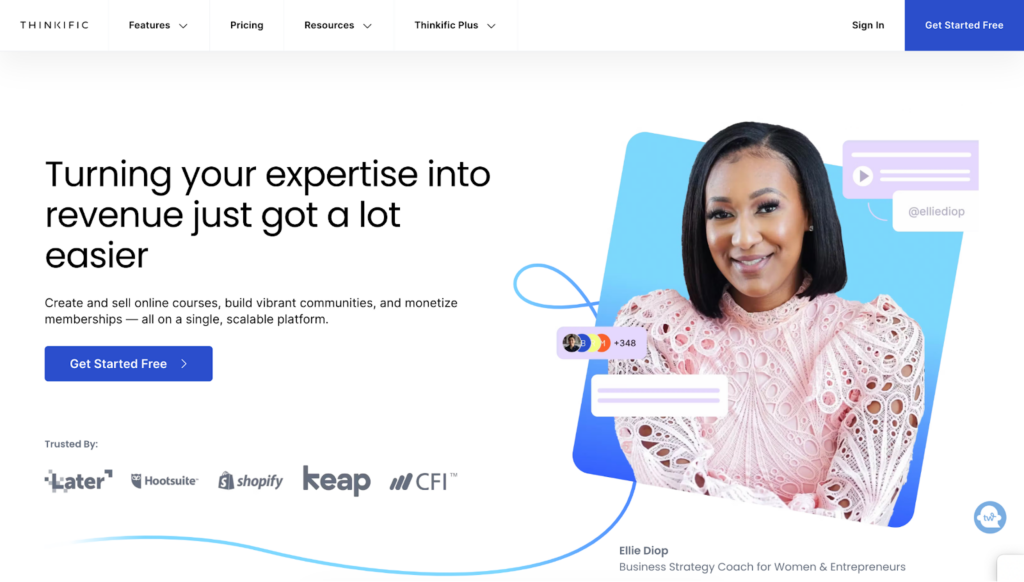
Thinkific is an eCommerce platform that allows you to create and promote online courses, build private communities, and monetize memberships. If you’re looking to create and gate an online course, Thinkific’s the tool for you.
This platform has pre-made templates and a drag-and-drop editor that allows you to create courses quickly and easily. You can offer scheduled, self-paced, and even live lessons complete with media (text, images, videos, etc.), quizzes, assignments, and certificates.
You can also create a dedicated community where like-minded people who are interested in your brand can share ideas and discuss with one another (you can gate this community, too).
Thinkific also has a feature that allows you to build a landing page (or full website) to host your gated content. There are customizable templates, custom (sub)domains, and a slew of popular marketing tools you can integrate for a smoother workflow.
Pricing: Thinkific has two different sets of pricing tiers. For the Starter Plans, there’s a free forever tier. Paid plans range from $49/month (Basic) to $99/month (Start). The Scale Plans range from $199/month (Grow) to $499/month (Expand). Save 25% with an annual subscription.
There’s also Thinkific Plus, a powerful, scalable platform with enterprise-level features that scale with you as you grow. Request pricing here.

Unbounce is an AI-powered landing page builder and optimization platform that allows you to build high-converting landing pages that’ll “turn your visitors into leads, sales, and signups”.
This platform has hundreds of industry-optimized templates for you to choose from and a drag-and-drop editor to help you customize your template of choice. In addition to the regular Classic Builder, Unbounce offers a Smart Builder, which comes with pre-optimized templates and uses AI to generate high-converting web copy.
This nifty feature also recommends landing page improvements in real time and lets you create pages roughly 50% faster than other builders. Other features of Unbounce include:
- Popups and sticky bars
- Custom HTML/CSS option
- AI-powered copywriting
- Dozens of third-party integrations
- AI optimization
Pricing: 14-day free trial. The paid plans range from $99/month (Launch) to $625/month (Concierge). Save 25% with an annual subscription.
Alternatives
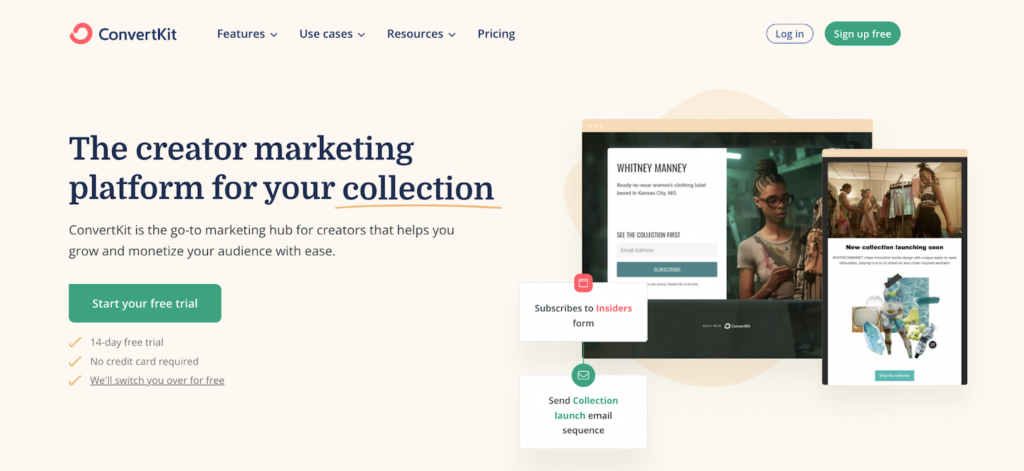
ConvertKit is an email marketing platform designed specifically to help content creators and content-driven business owners connect with their audience and earn an income online. You can connect ConvertKit to your lead capture forms to deliver emails to subscribers.
This solution comes with robust features that allow you to:
- Create stunning landing pages via premade templates and a visual editor (for customization)
- Create custom opt-in forms with different incentives and specific calls-to-action
- Create and schedule drip email sequences to be delivered to subscribers at preset dates
- Create automated workflows by setting up automation rules and triggers
Other key features of ConvertKit:
- A creator network for cross-promotion
- A commerce platform to help creators sell products to their audience
- Integration with third-party apps like OptinMonster, WordPress, and Shopify
Pricing: Free plan available (for up to 1,000 subscribers). Paid plans range from $15/month (Creator) to $29/month (Creator Pro), for up to 300 subscribers.
Alternatives
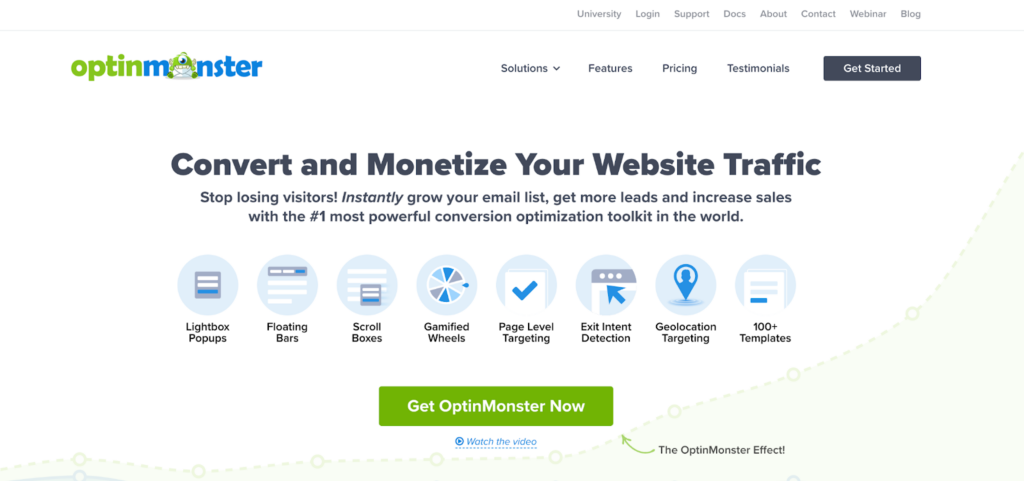
OptinMonster is an out-of-the-box, cloud-based solution that can help you generate leads and automate your marketing campaigns by creating and A/B testing custom opt-in forms.
With this platform, you can create many kinds of forms, including lightbox popups, floating bars, inline forms, slide-ins, and scroll boxes, to mention a few. There’s a drag-and-drop form builder that you can use to customize your forms’ branding, including the color palette, images, and messages.
OptinMonster also allows you to segment your email list based on your subscribers’ interests and website interactions. There’s also built-in page-level targeting, so that you can show unique campaigns or offers based on your list segments. What’s more, you can A/B different form variations (form headline, style, layout, content, and opt-in trigger) to find the version that converts best.
Other key features of OptinMonster include:
- Exit-Intent® Technology that serves up targeted campaigns to users as they’re about to leave your website.
- Campaign management
- Campaign analytics
- Geo-location targeting
Pricing: The paid plans range from $9/month (Basic) to $49/month (Growth), billed annually.
Alternatives
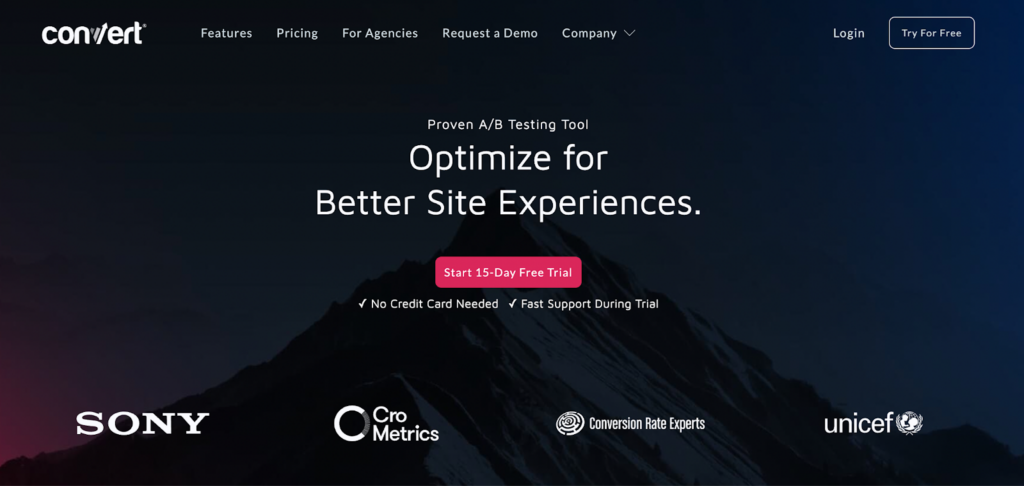
Convert is a powerful conversion rate optimization platform designed to help businesses improve their website’s performance and increase conversions. It mainly does this through its robust testing capabilities, which allow you to run A/B tests and multivariate tests on your landing page/website.
Convert has a nifty visual editor that you can use to easily create variations of web pages — no coding skills needed. Then you can run experiments to see which variation converts better, optimize user experiences, and finetune conversion paths.
This platform also allows you to personalize your content and experiences based on demographics, user behavior, and other parameters, which can significantly increase user engagement and conversion rates. You’ll also get detailed analytics and reports that offer insights into the performance of your tests, conversion metrics, and visitor behaviors. This enables you to make data-driven decisions for your business.
Other Convert features include:
- Support for various testing methodologies, including JavaScript-based testing, server-side testing, and URL testing
- Multi-page and full-stack experiments
- Seamless integration with popular marketing tools like Crazy Egg, Google Analytics, HotJar, and WordPress
Pricing: 15-day free trial. The paid plans range from $99/month (Community Web) to $1,599/month (Expert). There’s a custom Enterprise plan for large companies. Save 30% with an annual subscription.
Alternatives
- VWO (Visual Website Optimizer)
- Optimizely (for very large enterprises)
- SiteSpect
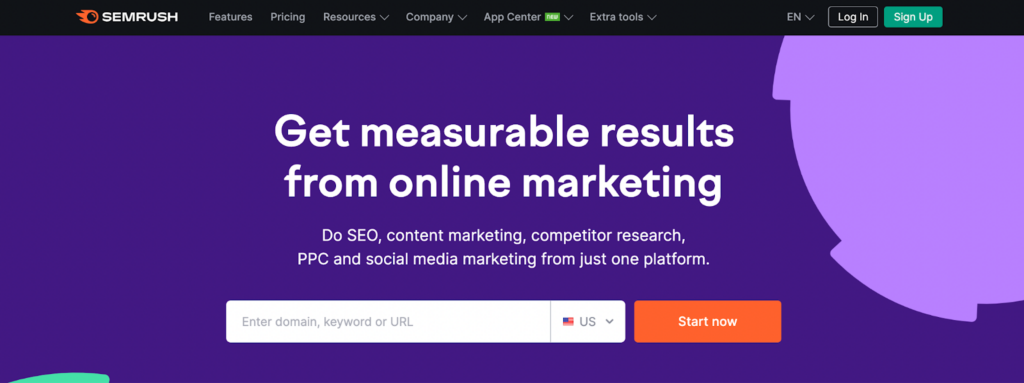
Semrush is a full-stack SEO suite that can help you increase the visibility of your website. With Semrush, you can:
- Find good long-tail keywords to optimize your landing page and blog posts. When you analyze a keyword, Semrush will show you its volume, keyword difficulty, related keywords, and even the web pages that are already ranking for it.
- See your competitors’ positions on the SERPs. You can also analyze their online strategies, including their backlink profile, organic and paid search tactics, and more. This gives you an idea of what to focus on.
- Conduct a technical audit of your website to identify issues that might affect its performance in search engines.
- Find profitable keywords to use in your PPC advertising strategy.
Some other things you can use Semrush for include:
- Social media analysis
- Market research
- Content marketing
- Position tracking
- Local SEO
- Content optimization
Pricing: The paid plans range from $129.95/month (Pro) to $499.95/month (Business). Save up to 17% with an annual subscription.
Alternatives
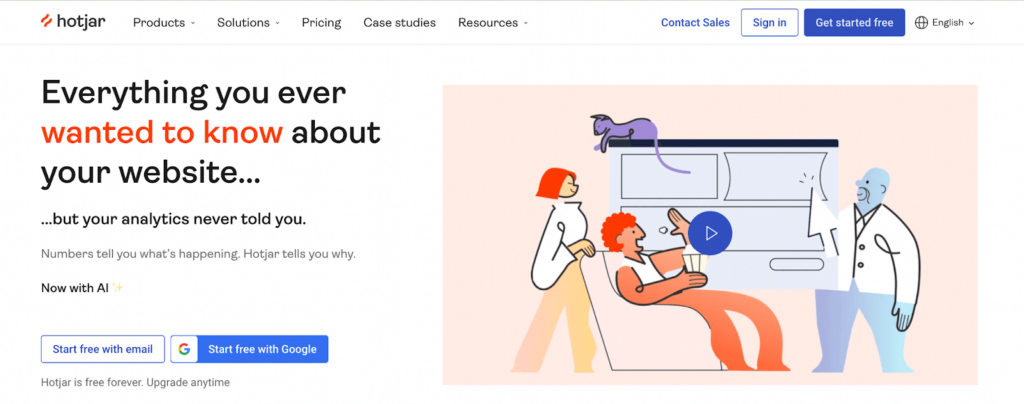
Hotjar is an all-in-one digital experience insights platform that can help you understand your visitors’ behavior and create engaging experiences that yield results.
The most prominent Hotjar feature is Heatmap, which visually represents the parts of your website with the most visitor activity. With the heatmap feature, you can see which parts of your landing page visitors pay attention to, where they click, and how far they scroll, which helps you determine how much interest they have in your landing page elements.
HotJar also offers session recordings of user visits so you can watch how people interact with your landing page in real time. You also get feedback and survey tools to interact with your visitors, which can help you increase conversions.
Other features of HotJar include:
- Activity dashboard
- Customer journey mapping
- User interviews
- Quantitative and qualitative data analytics
Pricing: Free plan available. The paid plans range from $39/month (Plus) to $213/month (Scale). Save 20% with an annual subscription.
Alternatives
Good landing page builders track conversion data, but they don’t track visitor data, such as the PPC keyword they used or the channel they came from. With Google Analytics, you get a bird’s-eye view of how visitors interact with your landing page/website via metrics like:
- Website traffic
- Time on page
- Bounce rate
- New vs. returning users
- Performance by channel (social, PPC, email)
- Behavior by device (desktop, mobile, tablet)
- Page speed
This free tool also allows you to analyze user behavior based on acquisition data, behavioral data, demographics, and referral sources.

If you’re trying to see how fast your landing page loads and how mobile-responsive it is, Google Pagespeed Insights is the tool for you.
This free tool gives a complete website analysis, including a Core Web Vitals assessment on how good your user experience is. There’s also a diagnostics section that shows you any possible website issues you need to fix and an opportunity section that gives you suggestions on how to improve your site’s performance.
Note: Pagespeed Insights only tests one page at a time. If you want to analyze multiple pages at once, use the Site Speed tab in Google Analytics.
Unlocking your gated content potential
As a business, your two main goals are to: build brand awareness and drive sales.
While gated content isn’t necessarily the best way to increase awareness, it’s an excellent way to find high-quality leads, build a targeted audience, and establish authority in your industry — all of which contribute to higher conversion rates and increased revenue.
To crat a winning gated content strategy, you need to create high-quality content and an SEO landing page to go with it. As you promote the landing page and get subscribers, nurture those leads with a personalized email campaign to convert into paying customers.
FAQ
- What is the goal of gated content?
The primary purpose of gated content is to collect personal information from web visitors in exchange for access to high-quality content. This allows businesses to generate qualified leads and nurture relationships with potential customers.
- What are some tips for optimizing gated content for SEO?
To optimize gated content for SEO, ensure that the accompanying landing page contains valuable, non-gated information for Google to index. Optimize that non-gated information by adding strategic keywords in the title, (sub)headings, content body, meta description, image alt texts, and URL.
- Do I gate or ungate my content?
To decide whether to gate or ungate your content, consider the value of your content and the objective for creating that content. If your content is in-depth and cannot be found ungated anywhere, and your goal is to generate qualified leads for your business, then gate it. But if your goal is to create brand awareness, it’s more beneficial to leave the content ungated.


